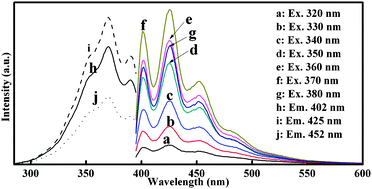Surface passivated silicon nanocrystals with stable luminescence synthesized by femtosecond laser ablation in solution†
Abstract
We report the synthesis of silicon nanocrystalsvia a one-step route, namely, femtosecond

* Corresponding authors
a State Key Laboratory of Silicon Materials, Zhejiang University, Hangzhou, Zhejiang, 310027, P. R. China
b Department of Physics, Shanghai University, Shanghai, 200444, P. R. China
c State Key Laboratory of Luminescence Physics and Chemistry and the Institute of Optical Communication Materials, South China University of Technology, Guangzhou, Guangdong, 510640, P. R. China
We report the synthesis of silicon nanocrystalsvia a one-step route, namely, femtosecond

 Please wait while we load your content...
Something went wrong. Try again?
Please wait while we load your content...
Something went wrong. Try again?
D. Tan, Z. Ma, B. Xu, Y. Dai, G. Ma, M. He, Z. Jin and J. Qiu, Phys. Chem. Chem. Phys., 2011, 13, 20255 DOI: 10.1039/C1CP21366K
To request permission to reproduce material from this article, please go to the Copyright Clearance Center request page.
If you are an author contributing to an RSC publication, you do not need to request permission provided correct acknowledgement is given.
If you are the author of this article, you do not need to request permission to reproduce figures and diagrams provided correct acknowledgement is given. If you want to reproduce the whole article in a third-party publication (excluding your thesis/dissertation for which permission is not required) please go to the Copyright Clearance Center request page.
Read more about how to correctly acknowledge RSC content.
 Fetching data from CrossRef.
Fetching data from CrossRef.
This may take some time to load.
Loading related content
